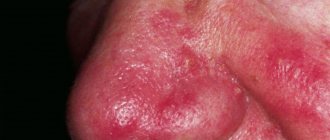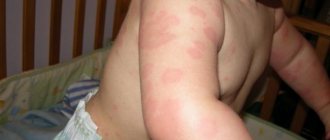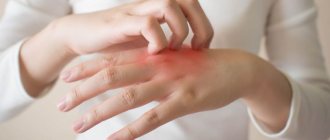What is prickly heat and why does it occur?
This is exactly the case when the name of the disease speaks for itself. Miliaria occurs when a person sweats frequently. At the same time, the excretory ducts of the sweat glands become blocked and a rash appears. Most often, the disease manifests itself in closed areas of the body - on the back, neck, legs, buttocks, armpits, and also in skin folds. If parents put a hat on their baby that is out of season, heat rash can appear on the head and even on the face, especially in those places where hair falls on the skin.
| Our expert Polina Vasilyeva dermatologist |
| Most often, heat rash can be noticed in those places on the body where it is damp and warm, primarily under the diaper. Heat rash also affects areas of the skin that have difficult access to air - the neck, upper chest, back, crooks of the arms and legs, armpits, lower back, behind the ears and in various skin folds. |
Miliaria occurs not only in children, but in adults too, but much less frequently. The reasons are quite obvious. Firstly, the baby's skin is softer and thinner. Secondly, the thermoregulation of a child under one year old is very far from ideal - he easily becomes hypothermic and even more easily overheats. Finally, an adult is able to understand that he is hot and take off excess clothes, but a newborn is completely dependent on the will of his parents. That is why the likelihood of heat rash in a one-month-old baby is much higher.
| Our expert |
Clinical researches
Clinical studies have proven the effectiveness, safety and tolerability of the products. The products are suitable for daily care of children's skin with mild to moderate forms of atopic dermatitis and during remission, accompanied by a decrease in the quality of life of patients.
Sources:
- Sukolin Gennady Ivanovich, Clinical dermatology. A short guide to the diagnosis and treatment of dermatoses, publishing house: Notabene, 2017
- Pankratov Valentin Gavrilovich, Pankratov Oleg Valentinovich, Infectious dermatology in the practice of primary care physicians, New Knowledge Publishing House, 2015
- Mancini A. J., Krouchuk D. P., Pediatric dermatology. Publisher: Practical Medicine, Directory, 2018
- Kildiyarova Rita Rafgatovna, Pediatrician for every day. Guide for doctors, publishing house GEOTAR-Media, 2022.
Polina Vasilyeva
dermatologist
| This disease most often occurs in young children, since their thermoregulation nerve centers are still imperfect and almost do not function. Sweating develops during the first two years of a child's life. Due to functional immaturity and a number of other factors, the sweat glands become blocked and a rash forms on the skin - miliaria. Factors influencing its appearance include, for example, incorrectly selected diapers, excessive wrapping of young children, lack or insufficiency of air baths, and much more. |
How diaper rash differs from prickly heat and why they often appear under a diaper, read here.
What does prickly heat look like in children?
At first, the symptoms look quite harmless - just a little redness. It is very important not to cause heat rash in a child: in the initial stages of development it is easy to get rid of, but later treatment may be required. The disease goes through the following stages:
- If parents do not think about how to remove heat rash from their child, or fight it incorrectly, the disease can move from the surface of the epidermis into the deeper layers of the skin. The inflammatory process begins and redness appears around the blisters.
- In advanced cases, bacteria penetrate the bubbles, causing their contents to become cloudy, and this looks very unpleasant not only in life, but even in the photo. The amount of rash increases, the skin begins to get wet. The disease develops especially quickly if the newborn is weakened.
- Mild redness of the skin, sometimes accompanied by itching. The baby may reach out to irritated areas, touch and scratch them.
- If the child continues to overheat, a rash appears in the red areas in the form of tiny blisters filled with clear liquid. They look almost like beads of sweat appearing, but only in a shell.
- If parents do not think about how to remove heat rash from their child, or fight it incorrectly, the disease can move from the surface of the epidermis into the deeper layers of the skin. The inflammatory process begins and redness appears around the blisters.
- In advanced cases, bacteria penetrate the bubbles, causing their contents to become cloudy, and this looks very unpleasant not only in life, but even in the photo. The amount of rash increases, the skin begins to get wet. The disease develops especially quickly if the newborn is weakened.
- Mild redness of the skin, sometimes accompanied by itching. The baby may reach out to irritated areas, touch and scratch them.
- If the child continues to overheat, a rash appears in the red areas in the form of tiny blisters filled with clear liquid. They look almost like beads of sweat appearing, but only in a shell.
Don't let heat rash develop and become a problem that requires treatment. When the first symptoms appear on the baby’s back, head, face or other places on the baby’s body, eliminate the cause of overheating. If this doesn't help, consult a doctor!
| Our expert |
When is urgent pediatrician care needed?
- if, subject to hygiene rules and treatment, the rash does not go away after 3 days;
- if the rash interferes with the child’s normal sleep, causes itching, pain and anxiety;
- if there is serious inflammation and swelling at the site of the rash;
- if ulcers with an unpleasant odor or cracks have formed in the affected areas;
- if the baby has a fever;
- if prickly heat in an infant continues for more than three days, and instead of improvement (drying out of the rash), the opposite process occurs (yellow or white liquid appears inside the blisters, the scale of the rash increases, and the child behaves very restlessly), consult a pediatrician immediately;
- If bloody contents are released from the rash, and the baby begins to vomit, call an ambulance immediately.
Such symptoms may signal an infectious process, and it will be difficult to cope with it without the help of a doctor. Contact your pediatrician: he will either prescribe treatment on his own or refer the child for a consultation with a dermatologist.
Polina Vasilyeva
dermatologist
| Miliaria does not require special treatment. It is necessary to change the care regimen and keep the baby's skin clean to avoid infection. |
In cases where prickly heat has developed from redness to a rash, and then bacterial infection occurs, treatment with special creams and ointments may be prescribed. If the symptoms show that the disease has reached a serious stage, consult a doctor and he will tell you how to treat it. Take regular photos of problem areas to track progress.
| Our expert |
Polina Vasilyeva
dermatologist
| Rashes can be treated with products containing zinc oxide (sudocrem), or diaper cream, powder. If you are concerned about itching, a cream with dexapanthenol (“Bepanten”, “Bepanten plus”, “Cicaplast”) or soothing creams that are sold in pharmacies will help. The products “Drapolen”, “Bepanten”, “Desitin” - their It is recommended to apply a thin layer and do not put on the diaper until completely absorbed. |
What else should be in a home first aid kit for newborns? Read here.
How to prevent heat rash in a child?
Prevention of heat rash is very simple - you just need to make sure that the child is comfortable and does not sweat. Here is a list of rules you need to remember:
- Create the right climate in your baby's room. Maintain the temperature at 18–20 °C and don’t worry that the newborn will freeze - this will be just right for him.
- If your baby's crib is exposed to direct sunlight, move it to a different location.
- Ventilate the room regularly, do not allow the air to stagnate.
- Do not buy clothes for your baby made from synthetic fabrics that do not breathe. Choose natural.
- Bathe your baby daily.
- Do not wrap your child up - both at home and on walks.
- Change diapers at least every 3-4 hours. After you've removed the used diaper and dried your baby's skin, let her breathe for a few minutes.
Learn to recognize the symptoms of overheating. If the child becomes lethargic and his face turns red, it means he is very hot. During a walk, especially in the cold season, these signs are easy to miss: the baby’s face, as the only open part of the body, rather reflects the weather outside than the general condition of the body. Gently slide your hand under your baby's clothes and check the back of the neck. If the baby's skin is dry and warm, everything is fine, but if it is wet, the baby is overheated, and this may result in the appearance of heat rash.
How to distinguish heat rash from allergies in a child?
An allergy is a pathological reaction of the immune system, and it is usually not exchanged for such trifles as local redness on the face or back. Allergy symptoms manifest themselves in a complex manner, often accompanied by nasal congestion and runny nose, shortness of breath, and redness of the eyes. If at the same time a rash is discovered on the baby’s body, the raging immune system usually “draws” mirror pictures. For example, skin problems occur on both elbows at once, rashes appear on the stomach or groin, symmetrical relative to the center line of the body.
The allergy usually comes out in the form of eczema (distinguished by the formation of tiny blisters that burst very quickly and leave weeping wells) or urticaria (almost unmistakably recognized by raised, flat blisters). These symptoms are completely different from prickly heat. If in doubt, look on the Internet for photos of these skin diseases. Better yet, take a photo of the problem skin area yourself and send it to the doctor.
Due to inexperience, other skin diseases can be mistaken for heat rash in a child, but they also have their own distinctive characteristics.
- Miliaria and contact dermatitis
Contact dermatitis is a direct response of the skin to an irritant and, true to its name, is always limited to areas of contact. For example, if the problem is in the composition of new socks, redness will appear on the legs, right under them, and if in the new shampoo, on the head.Dermatitis occurs quite easily and spontaneously in dry places - where prickly heat has nothing to do. And he’s in no hurry to leave—days, sometimes weeks, pass before the symptoms of this disease disappear.
- Heat rash and diaper rash
Diaper rash also likes warm and humid places, but has a different cause. They occur as a result of the development of a bacterial infection in irritated or chafed areas of the skin on the neck, groin, armpits and other places. Diaper rash is more painful for newborns and children under one year old, because they have many secret folds on the body.At the first stage of development, diaper rash shows the same symptoms as prickly heat - redness on the skin. Later, cracks appear in these places, then ulcers. The fact that it is almost impossible to distinguish these two diseases in the early stages should not upset you. Start treatment on two fronts at once - diaper rash cream plus control and prevention of overheating from prickly heat. One will help, and the other definitely won't hurt.
Is heat rash only a disease of newborns? Can it appear in a baby at 1, 2, 3 years old?
As the baby grows up, he expresses his feelings more and more clearly - first with actions, and then with words. Already at 1 year old, a child is able to pull off a hat that is too warm, at 2 years old he can, albeit primitively, explain that he is hot, and at 3 years old he can talk about the reasons for the discomfort in detail.
Learn to understand your child's signals, listen to him and do not ignore him. If your baby warned you about overheating, but you did nothing and then discovered prickly heat - well, it’s clear who is to blame and what to do next time.
Authors: Huggies experts, dermatologist Polina Vasilyeva
Read us on Yandex Zen
Traditional methods of treatment
In the initial stages of the pathology, when prickly heat is localized in the diaper area and in the folds of the skin, it can be treated with traditional methods. These are herbal decoctions that are added to baths, used as rubdowns or lotions.
Before using a new plant, you must first rub its decoction on a small area of skin on the inside of the baby’s forearm to check for tolerance.
For newborns, herbs should be used with caution; they often cause an allergic reaction. There are only a few plants that are allowed at this age.
- Chamomile and string are used most often. You can brew them together or separately. They relieve inflammation, soothe itching and irritation, and disinfect. You can brew them in the proportion of 120 g of herb per half liter of boiling water. The cooled and strained broth is poured into the bath.
- Yarrow has an anti-inflammatory effect, normalizes the functioning of the sebaceous glands and is considered a natural antibiotic. Therefore, its use is effective for prickly heat. You need to make a decoction of 20 g of dry grass and a glass of boiling water. After cooling, strain and add to the bath water.
- Oak bark cleanses, dries wounds, and disinfects. The decoction relieves inflammation and normalizes the functioning of the sweat glands. 20 g of bark per 500 ml of boiling water is enough. After brewing, you need to boil it for 5 minutes so that more tannins are transferred into the water.
- A decoction of bay leaves is used for baths and rubbing the skin. It heals wounds, stimulates regeneration processes, and disinfects. You need to pour 7 leaves with a glass of water, bring to a boil and boil for 5 minutes. Wash the areas affected by prickly heat with the decoction using cotton pads.
You can wipe the baby's skin with a soda solution. Dissolve a teaspoon of soda in a glass of warm boiled water. Soak a cotton pad in the solution and wipe the affected areas without pressing on the skin.











